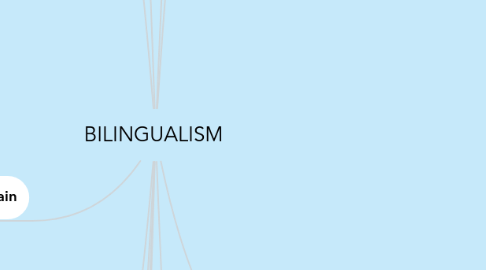
1. Advantages of Multilingualism
1.1. 1.You have more career prospects available to you because of multilingualism
1.1.1. When you can speak multiple languages, then your value as an employee increases exponentially with each new language that you learn
1.2. 2. It creates an opportunity for early diversity.
1.2.1. Ask the average child what they care most about in life and it won’t be cultural issues, political debates, or the status of immigration or religion.
1.3. 3. Learning one new language makes it easier to learn more.
1.3.1. Once a second language has been learned and a student can officially call themselves “bilingual,” it becomes much easier for that person to learn a third language, and then a fourth, and so on
1.4. 4. You can travel with more convenience because you understand what others are saying.
1.4.1. Although one of the disadvantages of speaking multiple languages is an almost constant need to prove your nationality, being multilingual makes it a lot easier to travel around the world.
1.5. 5. You can teach the benefits of multilingualism to the next generation.
1.5.1. If you know how to speak multiple languages, then you can pass this trait onto your children with relative ease. All that you need to do is speak all of the languages at home regularly.
2. Bilingualism Characteristics
2.1. ●Bilingual people are most often part of two cultures or a culture where more than one language is used.
2.2. ●Bilingual people use each language in different areas of their lives. Some may speak one language at home and the other for everyday business.
2.3. ●Bilingual individuals may not be able to translate quickly. This doesn't mean they don't know the language well. Words don't automatically translate equally into another language, so it takes some thinking to figure out a good translation.
2.4. ●Bilinguals sometimes mix languages when speaking to each other.
3. The benefits of a bilingual brain
3.1. ●Developing strong thinking skills
3.1.1. ●Focusing remembering and making decisions
3.2. ●Cultivating greater cultural awareness
3.2.1. ●Using logic
3.2.1.1. ●Increasing Reading comprehension
3.3. Video about the benefits of a bilingual brain
4. Types of Multilingualism
4.1. • Additive:
4.1.1. Learning of the second language does not interfere with first language.
4.2. • Subtractive:
4.2.1. Learning of second language does interfere (replaces) with first language.
5. Definition of Multilingualism
5.1. Multilingual means using or having the ability to use several languages with the same amount of fluency.
5.2. This video shows the mean of multilingualism.
6. Importance of being multilingual nowadays
6.1. Tolerance & respect towards other cultures
6.2. Personal growth
6.3. Job Mobility
6.4. Abroad Study
6.5. Broadens employment opportunities
6.6. Increases vocabulary & effectiveness of speech
7. What are the differences in bilingual and multilingual education?
7.1. The main difference between bilingual and multilingual education is how the “minority”language (the language that is not dominant within the community) is used.
7.1.1. Bilingual
7.1.2. Multilingual
8. Definition of Bilingualism
8.1. Bilingualism is the ability to speak two languages .The term can refer to individuals
8.2. wdefrghjkujhgfds
9. Two basic types of Bilingualism
9.1. Individual Bilingualism :
9.1.1. The use of two (or more) languages by an individual
9.2. Societal Bilingualism :
9.2.1. The use of two (or more) languages within a given community
9.3. This video explain the types of bilingualism
10. Five important variables in relation to bilingualism:
10.1. 1. Degree of Bilingualism of Balance Bilinguals
10.1.1. Degree of Bilingualism dominat Bilinguals
10.1.1.1. Degre of Bilingualism/ Passive and Regresive Bilinguals
10.1.1.1.1. Degree of Bilingualism /Semilingual and Limited
10.1.1.1.2. Individual who are gradually losing competence in one language,usually because disease.
10.1.1.2. Individuals who are dominant in one language
10.2. 2. Context of Bilingual Language Acquisition
10.2.1. Primary context / natural bilingualism
10.2.1.1. These are situations in which a boy or girl acquires both languages in their natural form and does not require a grammatical structure to follow.
10.2.1.1.1. Naturalistic fused setting
10.2.2. Secondary context / school bilingualism:
10.2.2.1. These are situations in which a boy or girl acquires a unique language in an educational environment such as school.
10.2.2.1.1. Naturalistic separate setting
10.3. 3. Age of acquisition
10.3.1. Language attainment , where the children who acquired the second language before six years of age were able to achieve native-like competence.
10.3.1.1. Age is a consideration when discussing or assessing bilinguals and the usual distinction made is between early bilinguals and late bilinguals
10.3.1.1.1. Early Bilinguals are those who are exposed to both languages before adolescence
10.3.1.1.2. Late Bilinguals are those who acquire the second language after adolescence.
10.4. 4. Social Orientation
10.4.1. social bilingualism refers to the presence of two or more languages in a given society. Many countries include various language or speech communities that is, groups that speak several languages or dialects.
10.5. 5. Additive vs. Subtractive Bilingualism.
10.5.1. Losing a native language may seem impossible, but is a very real possibility if the language learner completely immerses themselves in the culture of the second language.
10.5.1.1. That second language will become the dominant one in the learner’s brain, taking over out of necessity.
10.5.1.2. This happens because the brain is able to quickly adapt to its surroundings by automatically doing the following: organizing, compiling and ridding itself of what isn’t needed.
11. Ways of Acquisition
11.1. .• Successive Bilingualism
11.1.1. Learning one language after already knowing another.
11.2. .• Simultaneous Bilingualism
11.2.1. Learning two languages as “first language”.
11.3. • Receptive Bilingualism:
11.3.1. Having the ability to understand a second language but not speaking it or not being able to speak it due to psychological barriers
